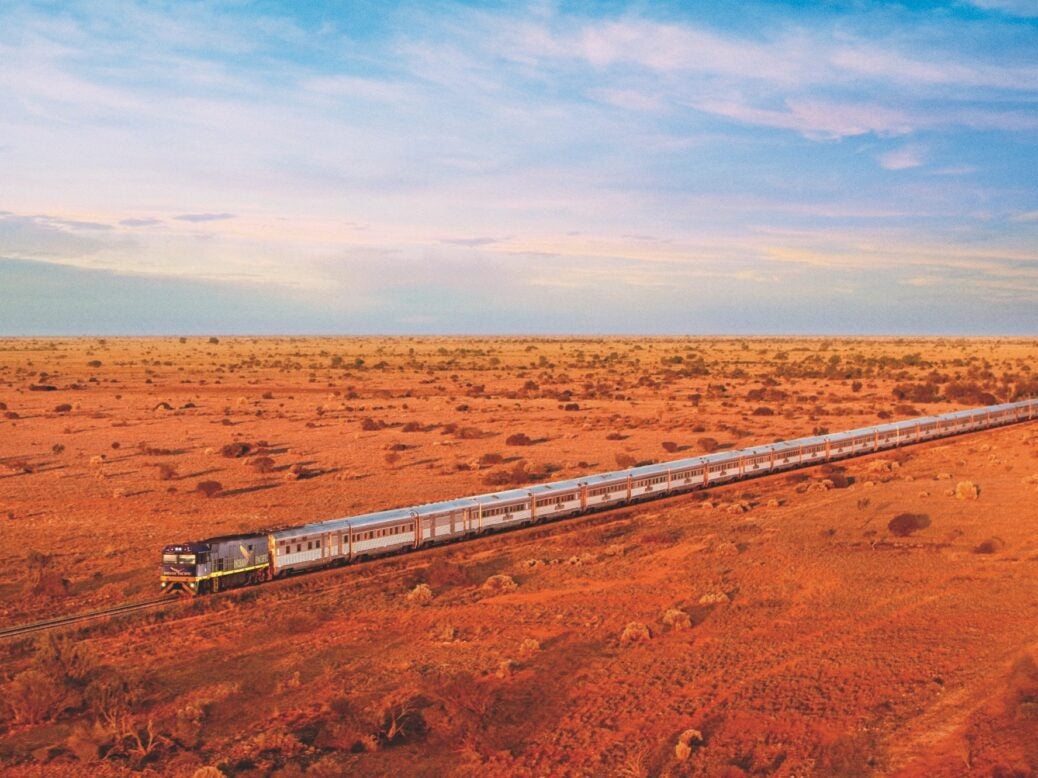
A 4,000km trip aboard the 1km-long Indian Pacific train might just be the best way to watch Australia unfold, finds Andrew Harris
The sun-blanched, auburn hills roll in a gentle syncopation with the slow rhythms of the train, while puffs of white cloud hang in a cobalt sky. It could be one of those magical but rare Dorset days of summer.
However, the trees, with their gangly, ghostly appearance, give the game away. The parched, languorous landscape of Western Australia’s Avon Valley is basking in early autumn sunshine that’s anything but rare. This vista is the first frame of the Indian Pacific train’s epic journey as it heads out toward Sydney, more than 4,000km and four days away.
The behemoth stretches up to 1km long, has 40 staff, three kitchens, four restaurants, several lounges, and for those who can’t bear to be separated from their cars, it’ll take them too. Fast it is not, but clutching my glass of Bollinger as we lurch across a sea of spectacular and seemingly endless bush, I’m all the more thankful for that. I want my fill of this emptiness.
If you really want to embrace this big country with a small population, the Indian Pacific can serve it up in bite-sized instalments. The connection of Sydney by rail to Perth was completed in 1917, but only in 1970 was a standard gauge achieved, and the Indian Pacific named in honour of the oceans it connects.
Of the two classes of travel – gold and platinum – the place to be is platinum. With newly modernised cabins, comfortable beds, en-suite bathrooms and a dedicated lounge, it sits among the world’s great rail experiences. Large picture windows play a hypnotic documentary in a never-ending theatre of nowhere, through a slow, seductive sequence of landscape costume changes.
For hours, we plough a ramrod-straight path into an utterly flat landscape. This is the Nullarbor plain (Null Arbor, no trees), and our train is travelling along the longest stretch of unbroken straight rail track in the world (478km). Train manager Linley confirms the obvious – we are ‘pretty much in the middle of nowhere’ – and regales us about a PoW camp out here during the Second World War, without walls. The only place to escape to was certain death.
The journey is interspersed with impressive optional excursions. On one sortie, breakfast was waiting for us in the crisp morning sunshine on the platform of Rawlinna station. At 2.5 million acres, Rawlinna is the largest sheep farm in Australia. Using the platform for a communal breakfast was a stylish introduction to the solitude of the outback, even if omelette with fries seemed more like omelette with flies.
Four’s a crowd
At the ghost town of Cook, I meet half the population (ie two of them) nursing beers on their porch, where they tell me about their ‘great social life with the other couple’. They dismiss concerns about the 43°C heat and advise me to keep to the paths because of the snakes. It’s good to get off the train now and then. It’s also good to get back on.
Adelaide, where I take a breakfast tour around the markets, is the only off-train excursion into any sizeable conurbation. Arriving in the early evening into Broken Hill, the outback mining town immortalised in the film The Adventures of Priscilla, Queen of the Desert, the heavy heat of the day still hangs like a carcass. Standing outside the Palace Hotel is a man the size of a dumper truck squeezed into a summer dress and with false eyelashes big enough to stand a drink on.
During our final breakfast, the train winds through the Blue Mountains (though the summer fires have since diverted the train while tracks are repaired). This expanse of forest, waterfalls and canyons, inland from Sydney, has the train throwing off Instagram moments by the second as it traverses far-reaching green carpeted plateaux before descending into mist-laden landscapes.
The off-train excursion to the Blue Mountains is the most impressive. From Mount Victoria’s little colonial-era station, we are whisked by bus towards ‘Scenic World’, which isn’t the tourist hell its name implies, and as a basic introduction to the Blue Mountains is well worth the visit.
Negotiating the sprawl of Sydney’s suburbs, we are eventually face to face with our limo driver amid the mayhem of the Central Station. The sense of having really seen Australia, of having experienced it in all its jaw-dropping magnificence from one coast to the other, is palpable. As a way of absorbing it all while staying tethered to life’s little luxuries, the Indian Pacific is unbeatable.
Andrew Harris traveled to Australia before the pandemic. Indian Pacific train from Perth to Sydney (and vice-versa), low season in platinum class from A$3,799 (approx. £2,000). Qantas now flies nonstop to Perth. Business class return from £5,078. For more, visit journeybeyondrail.com.au and qantas.com
Feature image: Steve Strike
More from Spear’s
Philanthropy: Princess Eugenie on Ascension Island’s sustainable fishing success story
Max Johnson on Amankila, Bali: ‘Exudes luxury and comfort’
Spear’s Wealth Insight Forum 2021: Watch on demand now






